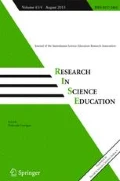Abstract
This paper presents a study of the design questions that children ask as they work technologically in school. Thirty-nine school aged children's technological work on “cubby building” is mapped and discussed. Data sources included video recording, worksamples, photographs with annotations of work in progress and when completed, and ethnographic field notes. The findings support the view that children's design questions and briefs arise at various points throughout the lesson sequence, demonstrating the iterative nature of design, make and appraise within and across lessons. The formulation of design questions evolved as children interacted, negotiated, played and worked in technological ways. For young children, playing with the “product” or “process” was an important part of working technologically. For the older children, the possession of technological skills for joining materials to achieve the desired outcome was a key factor.
Similar content being viewed by others
References
Anning, A. (1994). Dilemmas and opportunities of a new curriculum: Design and technology with young children.International Journal of Technology and Design Education, 4, 155–177.
Biddulph, R., & Osborne, R. (1984).Making sense of our world: an interactive teaching approach. Hamilton, NZ: Science Education Research Unit, University of Waikato.
Curriculum Corporation. (1994).A statement on technology for Australian Schools. Melbourne, Victoria: Curriculum Corporation.
Egan, B. A. (1992). How do children perceive the act of drawing? Some initial observations of children in an infant school.DATER, 95, 10–14.
Fleer, M. (1992). Introducing technology education to young children: A design, make and appraise approach.Research in Science Education, 22, 132–139.
Fleer, M. (1993). Can we incorporate the principles of the national statement on technology education into our early childhood programs?Australian Journal of Early Childhood, 18(4), 26–34.
Fleer, M. (1996). Talking technologically in preschool oand school: Three case examples.Australian Journal of Early Childhood, 21(2), 1–6.
Fleer, M., & Sukroo, J. (1995).I can make my robot dance: Technology for 3 to 8 year olds. Carlton, Victoria: Curriculum Corporation.
Fleer, M. (in press). The science technology: Young children working technologically.International Journal of Technology and Design Education.
Fry, T. (1994, Decemcer).Design and action and design reinvented. Unpublished Keynote Address, Technology Educators Association of the ACT, ACT Department of Education and the University of Canberra, School of Environmental Design, ACT, Australia.
Griffin, H. (1984). The coordination of meaning in the creation of a shared make-believe reality. In I. Bretherton (Ed.),Symbolic play. The development of social understanding (pp. 73–100). New York: Academic Press.
Hayes, D., Symington, D., & Martin, M. (1994). Drawing during science activity in the primary school.International Journal of Science Education, 16(3), 265–277.
Jane, B. (1995).Technology in the primary curriculum: A teacher's perceptions and student's learning. Unpublished PhD thesis, Monash University, Melbourne, Victoria, Australia.
Jeffery, J. R. (1991). An investigation into the effect of systematic design methods in craft, design and technology (CDT).International Journal of Technology and Design Education, 1(3), 141–149.
Jones, A., & Carr, M. (1993).Analysis of student capability.Working paper of the Learning in Technology Education Project (Vol. 2). Hamilton, NZ: University of Waikato Centre for Science, Mathematics and Technology Education Research.
McLaren, S. (1997). Value judgements: Evaluating design. A Scottish perspective on a global issue.International Journal of Technology and Design Education, 7, 259–276.
Rennie, L., & Jarvis, T. (1995). Children's choice of drawing to communicate their ideas about technology.Research in Science Education, 25(3), 239–252.
Ritchie, S. M., & Hampson, B. (1996). Learning in-the-making: A case study of science and technology projects in a year six classroom.Research in Science Education, 26(4), 391–407.
Rogers, G. (1998, July).The designing stage of design, make and appraise: A case study involving young children designing. Paper presented at the Australasian Science Education Research Association conference, Darwin, NT.
Roth, W.-M. (1995). Form “wiggly structures” to “unshaky towers”: problem framing, solution finding, and negotiation of course of actions during a civil engineering unit for elementary students.Research in Science Education, 25(4), 365–382.
Roth, W.-M. (1996). Learning to talk engineering design: Results from an interpretive study in a grade 4/5 classroom.International Journal of Technology and Design Education, 6, 107–135.
Roth, W.-M. (1998).Designing communities. London, England: Kluwer Academic Publishers.
Yin, R. K. (1984).Case study research. Design and methods. (Applied Social Research Methods Series, 5), Beverly Hills, CA: Sage Publications.
Author information
Authors and Affiliations
Corresponding author
Rights and permissions
About this article
Cite this article
Fleer, M. Interactive technology: Can children construct their own technological design briefs?. Research in Science Education 30, 241–253 (2000). https://doi.org/10.1007/BF02461631
Issue Date:
DOI: https://doi.org/10.1007/BF02461631



